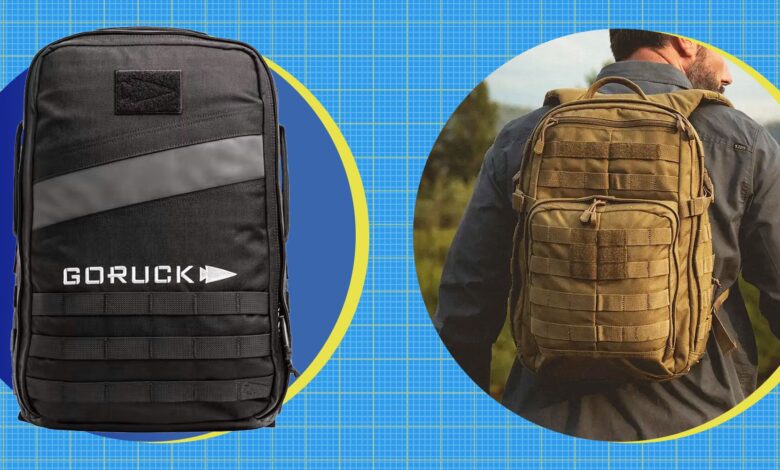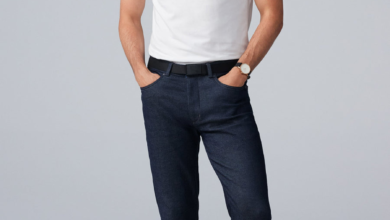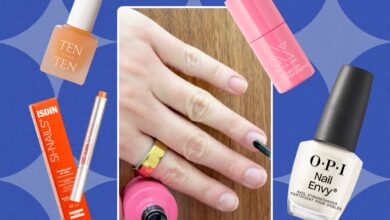The 6 Best Rucking Backpacks, Trail-Tested by Fitness Editors

Pros
- Intentional rucking design
- Extra lumbar padding
- Dedicated rucking plate sleeve keeps weight high and tight
Cons
- Hip belt not included
You’ve probably seen GORUCK’s packs somewhere in your IG feed— the brand is favored by a certain group of training professionals that are both prolific and public in their love of GORUCK’s products. When that happens, it’s natural to start feeling like it’s too much of a good thing. So does the brand live up to the hype? Short answer: absolutely. We found that in a sea of great backpacks, GORUCK’s range was best suited for rucking-specific activities.
The Rucker 4.0 in particular emerged as a winner. The padding blends the comfortable and the practical, with an extra 10 mm of EVA foam padding along the bottom section of the back panel supports the natural curve of your back and helps relieve pressure and balance weight. Adding to that sense of balance, the interior ruck plate pocket is elevated, keeping the weight high and secure to help prevent friction and injury.
We also like that the back panel and underside of the shoulder straps use High Tenacity CORDURA® to help prevent friction when rucking shirtless or with pilling-sensitive fabric like merino wool. We found the Rucker 4.0 to be intentionally designed at every level and, if anything, overbuilt, which is perfect for a pack you’ll lug heavy-weighted plates in.
Editor Charles Thorp adds “I first got the GoRuck 4.0 specifically for rucking on the trails by my house, but it quickly became my everyday bag as well. Everything that makes it a great rucking bag also makes it a great work bag, because no matter what kind of gear I’m taking to the office, from multiple laptops to recording equipment, the design supports proper posture while I’m on the move. On top of it being incredibly functional, I also like the utilitarian look of the bag in contrast to other options that have too much going on. While the pack doesn’t come with an integrated hip belt, it is compatible with the brand’s sold separately version for heavier weight and longer rucks.
While we’d love to see that included with the pack, it’s a smaller and more inexpensive addition for those who prefer it.
| Material | 1000D CORDURA |
|---|---|
| Hip Belt | Sold seperately |
Pros
- Multi-purpose functionality
- Great price-to-value
Cons
- Hip belt not included
Modern life is busy. Whether you’re working from home or still trekking into the office, reducing clutter and staying focused often means keeping your day-to-day kit tightly organized. If you’re looking for a pack that can pull double duty for day-to-day commuting and rucking workouts, then 5.11’s Rush series is the pick for you.
We found that the RUSH 12 2.0, despite having too many numbers in its name, is an intelligently designed, multi-purpose pack. The padded laptop sleeve doubles as a rucking plate compartment. The back paneling features four “pods” of extra padding that combine back support with airflow, helping mitigate the inevitable back swampage. And a separate back pocket is hydration bladder compatible, though the pack ships without one. Like GORUCKS Rucker 4.0, it doesn’t ship with a hip-belt but is hip-belt compatible if you choose to add one later. And the price-to-value ratio is unbeatable.
Phil Daru, a MMA performance coach who recently completed a 100-mile ruck adds that, “With a ruck bag you are looking for it to sit tight to the body, and high up on the back. It needs to be durable and able to carry a full kit of gear while traveling long distances. Pockets and compartments that compact and prevent items from moving around while you’re rucking are important to maintain balance and also protect against injury.” For him, this 5.11 bag fits the bill.
| Material | 1050D Nylon |
|---|---|
| Hip Belt | Sold seperately |
Pros
- Durable and anti-abrasive materials
- Hydration bladder included
- Quick release for shoulder straps
Cons
- Minimal strap padding
- Rucking plates are a tight fit
While other packs on this list are hydration-compatible, Camelbak MULE is the only pack with hydration as the first and foremost consideration. How seriously does Camelbak take fluid intake? The back paneling of the MULE has a skull emblem encircled by the motto “hydrate or die” This particular MULE comes from CamelkBak’s military spec range, which they also sell commercially.
They’ve upgraded several features with toughness in mind: the backpack uses 500D Double-rip Cordura Fabric for the ultimate combination of strength and durability and has quick-release buckles on the shoulder straps to ditch the pack if necessary. We found that, practically, this gave the M.U.L.E the strength to carry rucking plates and a full water bladder together. The downside? The straps are minimally padded and more than one rucking plate is a tight fit, so choose your weight class wisely.
| Material | 500D Double-Rip CORDURA |
|---|---|
| Hip belt | Included |
Advertisement – Continue Reading Below
Pros
- Large capacity
- Integrated hip belts
- User-friendly pockets and zippers
The hip belt is an invaluable tool for long-distance rucking. The belt redistributes weight from the shoulders and back to the hips, allowing your core and leg muscles to do the heavy lifting. Crucially, it also helps decrease lower back strain. While both the GORUCK and 5.11 packs offer aftermarket hip-belt add-ons, Mystery Ranch’s 32-Liter Rip Ruck is intentionally designed around an integrated hip-belt. We found that this could be frustrating for short rucking excursions where you don’t need the extra support, but crucial for long-distance efforts.
We found that the Rip Ruck is ideal for long distances. The hip belt is adjustable and supportive. The yoke, or in layman’s terms, the back panel, is adjustable to different torso sizes and the shoulder straps have two-point adjustability. We found this increased the amount of time it takes to dial in your initial fit, but these customizable options paid comfort dividends while rucking long distances, where even a little bit of discomfort can multiply. Storage-wise, the Rip Ruck can hold enough food and water and an extra layer for a long day out in the mountains.
We also found this pack’s zippers to be oddly satisfying to use, many of them designed for one-handed access, a useful feature after hours on the go.
| Material | Nylon/closed-cell foam |
|---|---|
| Hip belt | Included |
Pros
- Internal frame to support weight
- Fully adjustable back panel
- Multiple size options in the Zulu series
Cons
- No rucking specific plate sleeve
When it comes to carrying heavy stuff in bags, backpacking companies do it best. Sure, their weight distributions might be more optimized for tents and stoves and dehydrated food. But weight is weight, and a backpack that can handle 60 pounds of camping gear can also handle 60 pounds of cast iron. We found that, of the outdoor-focused backpacks, Gregory is the best at carrying heavier loads. The Zulu blends outdoor functionality with rucking-focused features. An adjustable pack panel helped testers customize their fit, ensuring that rucks were as comfortable as possible.
Adding to that, Gregory added extra panels to the lumbar area that allow the hip belt to flex with your natural movement. We found that this made a big difference with heavy loads, allowing the backpack to stay centered on our backs even as we rotated our torsos. Best of all? We liked the alloy and carbon fiber internal frame, which kept that pack itself light but structured and added support for piling in extra rucking weight. While we prefer the 30L range, there are others available in the Zuly range. Heads up, unlike other packs on this list the Zulu is not one-size-fits-all, so make sure to pick a length that fits your torso size.
| Material | 400-denier ripstop polyester |
|---|---|
| Hip belt | Included |
Pros
- Fully recycled material
- Capable of more than just rucking
Cons
- Hard to fit both a rucking plate and a hydration bladder
Over the past few years, REI’s house brand has quietly transformed from a budget pick within the store’s offerings to going toe-to-toe with its competition. Their Ruckpack—made of fully recycled materials—is no exception.We found the internal sleeve works for a laptop, 3L reservoir, or single ruck plate, depending on the brand and weight of the plate.
It’s hydration compatible, though if you use the internal sleeve for your rucking weight you’ll have to jury rig a different solution for your bladder. We also liked the elastic side water bottle pocket and the trekking pole attachment for storing poles when not in use. This bag also comes with an included rain cover, which we liked for long rucks with potential inclement weather.
| Material | Recycled ripstop nylon |
|---|---|
| Hip belt | Included |
Advertisement – Continue Reading Below

What Are The Health Benefits Of Rucking?
Personal trainer and Tonal Strength Coach Joe Rodonis says from a training perspective, rucking is “a great way to build endurance, promote recovery, and build strength/muscle (complementing a resistance training routine).” He also lists the benefits as Zone 2 cardiovascular conditioning, a general building of muscular endurance and strength, and promotes it as an active recovery option saying that he “loves adding a day or two of Rucking as an option for active recovery and mild conditioning.”

Are There Health Risks To Rucking?
In short, no more than any other physical activity. Rodonis says, “as a low-impact activity, there aren’t major health concerns; but there are areas that may receive strain.
Shoulders, traps, back – the nature of holding a weight backpack or vest will cause strain on the shoulders, traps, and back. Just make sure you have equipment that fits properly to help with this.
Feet, ankles – you’ll want proper footwear to support the extra weight you’ll carry and the distance you’ll be walking. The same way that you’ll want proper shoes for running, you’ll want proper support for a ruck to avoid things like blisters or general discomfort.”
If you plan on rucking on a trail or any remote areas, be sure you’re looking out for any uneven terrain. Try to off-road ruck without any unnecessary hinderences like noise-cancelling headphones or view-obstructing eyewear. Enjoying the sights and the sounds of the great outdoors is half the point after all.
Charles Thorp is the Fitness and Commerce Editor at Men’s Health, where he shares the best product recommendations in gym equipment, recovery tools, supplements, and more. Following an early life in athletics, Charles became a NASM-certified trainer and began writing programs alongside the most respected coaches in the world.
Since entering the world of fitness content, Charles has had the opportunity to learn from and train alongside high performance individuals from the NFL, UFC, NBA, Formula 1, CrossFit, US Olympics, and Navy SEALs. When he’s not writing about training programs or gear, he can be seen at the gym or in the wild, putting them to the test.









